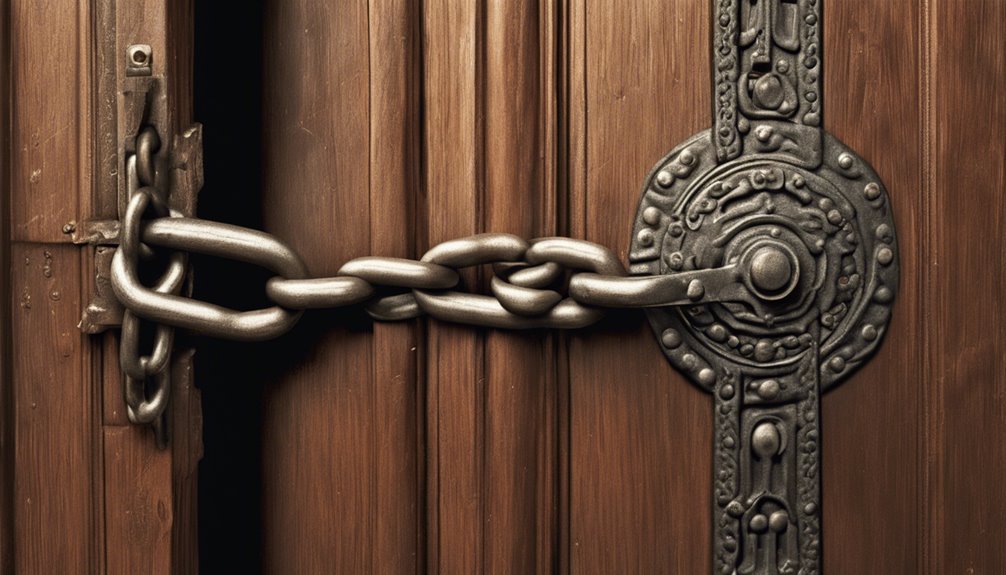Isn’t it unsettling to think about the multitude of unexpected visitors that could show up at your door? Door chains offer a straightforward yet effective way to enhance your home security, allowing you to engage with guests while keeping potential threats at bay. They’re not just a physical barrier; they also provide a sense of safety for you and your loved ones. But how do you choose the right one that fits your needs? Let’s explore the various features and benefits that make door chains a must-have for every household.
Key Takeaways
- Door chains serve as a secondary barrier, enhancing security while allowing limited door access for safe interaction with visitors.
- Ideal installation height for door chains is 54 to 60 inches from the ground, ensuring convenience and easy operation.
- High-quality door chains made from heavy-duty steel offer superior protection against break-ins and are a cost-effective security solution.
- Regular maintenance, including inspections and lubrication, is essential to ensure the longevity and effectiveness of door chains.
- Combining door chains with high-security locks provides an extra layer of protection, crucial for vulnerable populations and home safety.
Importance of Door Chains

While you might feel secure in your home, installing a door chain greatly enhances your safety.
Door chains serve as a secondary line of defense against unwanted intrusions while allowing you to engage with visitors safely. They restrict how far a door opens, giving you the opportunity to evaluate who’s on the other side before granting entry. Additionally, investing in high-security locks can significantly bolster your overall security strategy.
In addition, door chains deter potential intruders by adding an extra layer that requires more effort to bypass. This simple yet effective mechanism provides peace of mind, especially during the night or when you’re home alone. Utilizing additional security measures, such as high-quality deadbolt locks, can further strengthen your overall home protection plan.
Installation Requirements and Tools

Installing a door chain typically requires just a few essential tools and careful attention to the process. Before starting, gather a drill, screwdriver, measuring tape, level, and screws included with your door chain.
First, determine the ideal height for installation, usually at eye level for convenience. Use the measuring tape to mark the positions for the chain’s securing plate on the door frame and the door itself.
After marking, drill pilot holes for the screws to verify accuracy and prevent wood splitting. Secure the plate and the chain mechanism tightly, using the screwdriver for a snug fit.
Always double-check the alignment with a level to confirm proper functionality. Proper installation reinforces security and guarantees your door chain operates effectively.
Functionality of Door Chains

Door chains function as a supplementary barrier, allowing you to partially open your door while still providing a safety net against unwanted entry. This feature enables you to verify visitors without fully exposing yourself or your home.
When you engage the chain, it restricts the door’s movement, granting you control over access. They’re particularly effective in reinforcing your main door against push or force entry. Additionally, door chains are a cost-effective strategy that can be easily integrated with existing high-quality locks to enhance security.
Furthermore, when used in conjunction with high-quality deadbolts, door chains can significantly reduce break-in risks by adding an additional layer of protection.
Remember, a properly utilized door chain doesn’t replace deadbolts or locks but works effectively alongside them, thereby fortifying your security strategy.
Mastering these details will greatly elevate your home’s protective measures.
Safety and Security Benefits

Using door chains greatly enhances your home’s security by adding an extra layer of protection against forced entry.
This is particularly vital for vulnerable populations, such as seniors or those living alone, who may feel more at risk. Additionally, incorporating high-security locks can further reinforce the safety offered by door chains, ensuring that your entry points are well-protected. High-security locks feature advanced design techniques that make them significantly more resistant to picking and forced entry compared to standard locks.
Enhanced Home Security
While most people consider high-tech security systems for protecting their homes, door chains offer a simple yet effective layer of defense.
These robust devices enhance your home security by providing three key benefits:
- Immediate Barrier: Door chains prevent unauthorized entry, allowing you to open the door slightly while maintaining control over who enters.
- Visual Deterrent: Their presence signals that you take security seriously, potentially discouraging would-be intruders. Additionally, door chains can complement security upgrades that further enhance your home’s safety measures.
- Cost-Effective Solution: Unlike expensive security systems, door chains are an affordable way to bolster your home’s safety without sacrificing quality.
Incorporating door chains into your security strategy not only enhances your overall protection but also offers peace of mind that you deserve. Additionally, combining door chains with features like high-security deadbolts can significantly improve your home’s defenses against break-ins.
Invest in this essential defense today!
Vulnerable Population Protection
Many vulnerable populations, including the elderly, single parents, and individuals with disabilities, face unique safety challenges that make effective home security essential.
A door chain acts as a reliable barrier, allowing you to control access to your home while evaluating who’s at your door without fully opening it. This simple yet effective device provides peace of mind, enhancing your overall safety. Additionally, incorporating alarms into your security strategy can further enhance the deterrence effect of door chains.
Furthermore, installing a door chain is straightforward and cost-effective, making it accessible for various household budgets. By adding this layer of protection, you empower yourself to deter potential intruders while maintaining your independence. Furthermore, the incorporation of advanced home security technology can significantly enhance the effectiveness of traditional security measures like door chains.
In turn, this fosters a secure environment, enabling vulnerable populations to feel safer within their homes, thereby greatly improving their quality of life.
Maintenance for Longevity

To guarantee your door chain remains an effective deterrent against unwanted intruders, regular maintenance is essential. Neglecting this step can compromise your security.
Here are three key maintenance tasks you should perform:
- Inspect Regularly: Check for any signs of wear, corrosion, or damage on the chain and hardware. Replace components as needed to guarantee full functionality.
- Lubricate: Apply a suitable lubricant to the moving parts every few months. This prevents rust and guarantees smooth operation, enhancing the chain’s effectiveness. Regular lubrication is crucial to ensure padlocks and gate locks remain rust-free and functional.
- Tighten Screws: Periodically tighten screws and bolts to maintain strong connections. Loose fittings can greatly weaken your door’s defense.
Design and Positioning Tips

When installing your door chain, it’s essential to place it at the ideal height to guarantee it’s effective yet user-friendly.
Aligning the chain with the anchor properly will maximize its security features, and marking screw holes beforehand will streamline the installation process.
Follow these simple design and positioning tips to boost your home’s protection efficiently.
Ideal Height Placement
The ideal height for installing door chains typically falls between 54 to 60 inches from the ground.
This range guarantees both security and ease of use for most adults.
When determining the best placement, consider these factors:
- User Accessibility: Make sure that everyone in your household can easily operate the chain.
- Vision Line: Position the chain where you can still see outside for safety checks without fully opening the door.
- Door Type: Account for variations in door styles and sizes; adjust height accordingly for peak performance.
Aligning Chain and Anchor
Achieving ideal security requires careful alignment between the door chain and its anchor. Positioning your chain and anchor correctly not only enhances protection but also guarantees ease of use. Follow these guidelines for best alignment:
| Measurement | Chain Link | Anchor Placement |
|---|---|---|
| Height from Floor | 4-6 inches | Directly aligned |
| Distance to Edge | 1-2 inches | Centered on the frame |
| Chain Length | Adjustable | Fixed |
| Security Type | Heavy-duty | Reinforced |
| Aligning Angle | Parallel to door | Vertical alignment |
Marking Screw Holes
Now that you’ve aligned the chain and anchor for perfect security, it’s time to focus on marking screw holes accurately for installation. Precision here guarantees a sturdy and secure fit.
Follow these steps for best results:
- Use a Center Punch: Lightly tap the center punch on each marking to create a small indent. This helps guide the drill bit and prevents slipping.
- Check Alignment Again: Before you drill, double-check the alignment of the chain and anchor. Misalignment now can lead to weakened installation.
- Drill Pilot Holes: Drill pilot holes in the marked spots. This allows the screws to go in smoothly and prevents wood from splitting.
Quality and Efficacy Standards

When evaluating door chains for home protection, it is essential to understand that not all products meet the same quality and efficacy standards. A high-quality door chain enhances your security, while subpar models may compromise it. Consider factors like material durability, strength ratings, and installation ease. To guide your decision-making, refer to the table below:
| Criteria | High-Quality Door Chains | Low-Quality Door Chains |
|---|---|---|
| Material | Heavy-duty steel | Lightweight plastic |
| Strength Rating | 800+ lbs | 300 lbs |
| Installation Ease | Simple, quick setup | Complicated, time-consuming |
Investing in a reliable door chain guarantees you’re not just compliant with safety standards, but also elevates your home’s overall security. Additionally, it’s important to choose a lock type that aligns with your specific security needs to optimize your protective measures. High-security locks, with their advanced designs, provide enhanced resistance to unauthorized access and significantly bolster your home’s safety.
Types of Door Chains Available

When choosing a door chain, you’ll find a variety of materials like stainless steel and plastic, each offering different levels of durability.
You also have installation options ranging from surface-mounted to mortise systems, allowing you to select what fits your door best.
Understanding these choices can greatly enhance your home’s security.
Chain Material Options
Choosing the right chain material for your door chain can greatly impact your home’s security and durability. Different materials offer varying levels of strength, corrosion resistance, and overall reliability.
Consider these three options:
- Steel: Known for its exceptional strength, steel chains provide robust protection against break-ins. Guarantee rust-proofing for outdoor use. Additionally, many insurance providers consider the presence of security measures like deadbolts when evaluating a policy.
- Aluminum: Lightweight and corrosion-resistant, aluminum chains are great for homes in humid climates. However, they may lack the strength of steel.
- Stainless Steel: Offering a perfect balance between durability and corrosion resistance, stainless steel is ideal for versatile applications without compromising security. Investing in high-quality locks, including door chains, can enhance overall home security measures that protect your property.
Installation Variants Available
While guaranteeing your home’s security, it is essential to evaluate the various types of door chains available for installation. The right choice can enhance your protection and provide peace of mind. Here are some installation variants:
| Type | Description | Pros |
|---|---|---|
| Standard Door Chain | Metal chain attached to door frame | Cost-effective, easy to install |
| Heavy-Duty Chain | Reinforced option for security | Maximum strength, durability |
| Sliding Chain | Adjustable for various door sizes | Versatile, easy to use |
| Deadbolt Chain | Combines chain and deadbolt features | Enhanced security, dual protection |
Choosing an appropriate door chain type guarantees that you bolster your entryway’s security without compromising accessibility. Invest wisely for a safer, more secure home environment.
Cost-Effectiveness of Door Chains

Many homeowners find door chains to be a cost-effective security solution that boosts home protection without breaking the bank.
Door chains provide essential advantages over other security measures, including:
- Affordable Pricing: Most door chains cost considerably less than high-tech security systems, making them accessible for any budget.
- Low Installation Costs: Simple DIY installation means you won’t need to hire professionals, saving you money and time.
- Durability: Made from sturdy materials, a door chain requires minimal maintenance, ensuring longevity and continued security.
Alternative Security Measures

Although door chains offer a practical layer of security, combining them with other security measures can greatly enhance your home’s protection.
Consider installing deadbolts, which provide added strength against forced entry. Security cameras are another vital investment; they not only deter burglars but also give you peace of mind by monitoring your property.
Smart locks allow remote access control, letting you grant entry without being home. Don’t overlook motion-sensor lights to illuminate dark areas, making it harder for intruders to approach unnoticed.
Reinforcing windows with security films or bars can further safeguard vulnerable entry points.
Frequently Asked Questions
Can Door Chains Be Installed on Sliding Doors?
You can install door chains on sliding doors, but it requires careful consideration of the door’s design and frame.
Unlike standard hinged doors, sliding doors need adjustable or specially designed chains to guarantee security without obstructing movement.
When properly installed, these chains enhance safety, allowing a slight opening while preventing unauthorized access.
It’s essential to select high-quality materials and follow installation guidelines for maximum efficiency and durability in securing your sliding doors.
How Do I Choose the Right Door Chain for My Home?
Choosing the right door chain for your home requires balancing security and accessibility.
You want a robust chain that can withstand attempted breaches, yet it shouldn’t hinder your quick access when needed.
Consider materials like stainless steel for durability and choose a length that permits secure closure while allowing you to open the door slightly.
Confirm it’s compatible with your door type to maximize effectiveness.
Ultimately, prioritize a chain that suits your specific safety needs.
Are Door Chains Effective Against Forced Entry?
Door chains can be quite effective against forced entry, but they’re not impenetrable.
When properly installed, they provide an additional layer of security, allowing you to open your door partially to see who’s outside while keeping your home secured.
However, it’s essential to remember that they should complement other security measures, like deadbolts and door locks.
Can I Install a Door Chain Myself Without Professional Help?
Why pay a professional when you can easily do it yourself? Yes, you can install a door chain without professional help.
It’s a straightforward process involving basic tools, like a screwdriver and a drill. Just follow the manufacturer’s instructions carefully, ensuring you secure the chain at the right height for maximum effectiveness.
With a little patience and attention to detail, you’ll master this task and enhance your door security efficiently.
What Materials Are Typically Used to Make Door Chains?
Typically, door chains are made from durable materials like stainless steel, which resists rust and corrosion, ensuring longevity.
Some chains may feature a plastic or nylon coating for added protection and a softer touch.
You’ll also find various attachments, like heavy-duty brackets, often crafted from metal for strength.
If you want reliable security, choosing high-quality materials is essential, as it directly enhances the effectiveness and durability of your door chain.
Conclusion
In the domain of home security, door chains are your fortress, a sturdy chain binding together safety and peace of mind. Just like a watchful guardian, they stand ready to protect you and your loved ones from intrusion. By investing in these simple yet effective devices, you’re not just securing your door; you’re fortifying your sense of safety. Embrace this unsung hero of home protection, and let your front door resonate with the strength of assurance and security.






